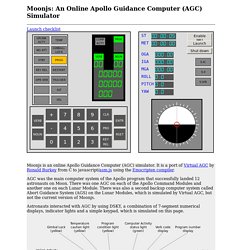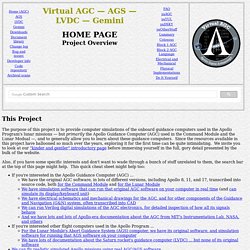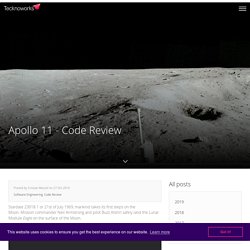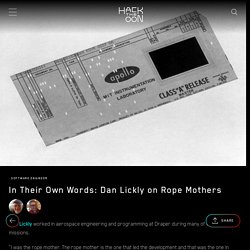

Atterraggio lunare in 4Kb - exedre - Medium. Il computer della missione Apollo è diviso in due moduli: uno nel Modulo di Comando che resta in orbita lunare e l’altro nell’Aquila (così gli astronauti chiamavano il Modulo Lunare che scende sul satellite) posizionato proprio sotto l’accesso che gli uomini usano per scendere sulla superficie.

La memoria del sistema è di due tipi. In termini moderni pensiamo a RAM e ROM ma sono in effetti un po’ differenti. La ROM è costruita come un intreccio di nuclei di ferrite a corrente coincidente in un tessuto di fili di rame racchiusi in una camicia di plastica. Il programma del computer Apollo è letteralmente cucito a mano sui nuclei di ferrite secondo l’orientamento dei bit.
Infatti il nucleo di ferrite funziona come una sorta di piccolo trasformatore di corrente e può essere attraversato al massimo da 64 fili. Tra anellini di ferro e fili di rame intrecciati ad uno ad uno siraggiunge l’incredibile (per allora) cifra di 36.864 parole di programma, ciascuna delle quali a 15 bit. Apollo Program. Apollo 11 in Real Time. A real-time journey through the first landing on the Moon This website replays the Apollo 11 mission as it happened, 50 years ago.

It consists entirely of historical material, all timed to Ground Elapsed Time--the master mission clock. Footage of Mission Control, film shot by the astronauts, and television broadcasts transmitted from space and the surface of the Moon, have been painstakingly placed to the very moments they were shot during the mission, as has every photograph taken, and every word spoken. Upon starting the application, select whether to begin one minute before launch, or click "Now" to drop in exactly 50 years ago, to-the-second during the anniversary. Navigate to any moment of the mission using the time navigator at the top of the screen. Main mission audio consists of space-to-ground (left ear), capcom loop (right ear), and on-board recorder (center, when available). Please contact Ben Feist for any inquiries. — Neil Armstrong Commander, Apollo 11. Online Apollo Guidance Computer Simulator. Moonjs is an online Apollo Guidance Computer (AGC) simulator.

It is a port of Virtual AGC by Ronald Burkey from C to javascript/asm.js using the Emscripten compiler. Virtual AGC Home Page. This Project The purpose of this project is to provide computer simulations of the onboard guidance computers used in the Apollo Program's lunar missions — but primarily the Apollo Guidance Computer (AGC) used in the Command Module and the Lunar Modual —, and to generally allow you to learn about these guidance computers.

Since the resources available in this project have ballooned so much over the years, exploring it for the first time can be quite intimidating. We invite you to look at our "kinder and gentler" introductory page before immersing yourself in the full, gory detail presented by the bulk of the website. Also, if you have some specific interests and don't want to wade through a bunch of stuff unrelated to them, the search bar at the top of this page might help. This quick cheat sheet might help too: The video clip above (courtesy of user Dean Koska and YouTube) illustrates some of the cute things you can do with Virtual AGC if you're of a mind to do so. Contents. I computer della NASA — il Progetto Apollo – DEV. developing software solutions. “..un piccolo passo per un uomo, un balzo gigantesco per l’Umanità…” La Luna, il satellite naturale della Terra, orbita ad una distanza media di 384.000 Km dalla superficie del nostro pianeta.
Complice incolpevole di migliaia di storie d’amore, ha rappresentato da sempre il luogo più remoto ed inaccessibile dell’immaginario collettivo: fu puntando ad essa che l’ex-presidente degli Stati Uniti John Kennedy volle dimostrare la supremazia americana nella corsa allo spazio, una corsa iniziata come tutti sanno al secondo posto dietro ai Sovietici. Ch2-6. Apollo 11 - Code Review. Stardate 23018.1 or 21st of July 1969, mankind takes its first steps on the Moon.

Mission commander Neil Armstrong and pilot Buzz Aldrin safely land the Lunar Module Eagle on the surface of the Moon. Meet Margaret Hamilton, the woman who in 1965 lead the Software Engineering Division at MIT Instrumentation Laboratory. In the picture below, she is standing next to the printed source code of the flight software for the Apollo Guidance Computer. Over 400 people worked on Apollo’s software, which helped people safely land on the Moon. You can bet your sweet ass they followed good software development practices. Readability is important All the source code for Luminary099 has 64.992 lines.
The software was submitted by 1 person and approved by 6 other people. Temporary does not exist in programming. Respect your users, but don’t trust them. Chrislgarry/Apollo-11: Original Apollo 11 Guidance Computer (AGC) source code for the command and lunar modules. Apollo 11 - Code Review. Dan Lickly Computer Engineering Interview. Dan Lickly worked in aerospace engineering and programming at Draper during many of the Apollo missions.

"I was the rope mother. The rope mother is the one that led the development and that was the one in charge of making sure everything came together. You are the final responsibility for whatever went in there and we were working on many things at the same time. You program and you went in and punched it on a keypunch and it put a batch of cards and ran it through a card reader. They had to all integrate their cards and put them together and submit it on one big run overnight and they printed out these huge listings that were six inches thick. Elaine Denniston was a young girl, maybe 23.
More... Hack the Moon.